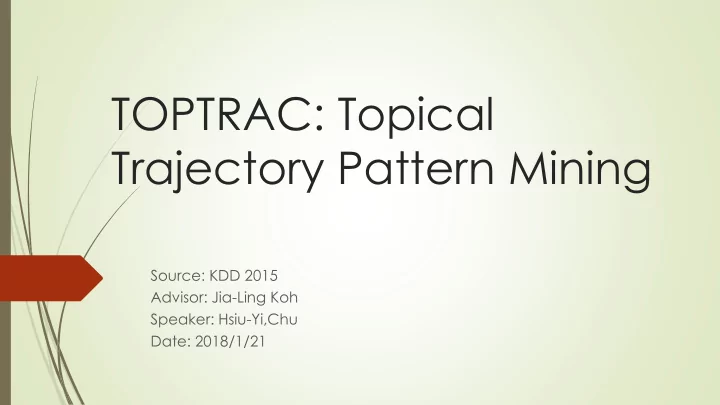

TOPTRAC: Topical Trajectory Pattern Mining Source: KDD 2015 Advisor: Jia-Ling Koh Speaker: Hsiu-Yi,Chu Date: 2018/1/21
Outline Introduction Method Experience conclusion
Introduction
Introduction Goal Topical trajectory mining problem: Given a collection of geo-tagged message trajectories, it’s to find topical transition pattern and the top-k transition snippets which best represent each transition pattern
Introduction Transition pattern: “Statue of Liberty” ”Time Square” Transition snippet: (m 1,1 , m 1,2 )in s 1 (m 4,1 , m 4,2 )in s 2
Introduction Definition Trajectory(s t ) geo-tagged message (m t,i ) Geo-tag G t,i : 2-dim vector(G t,i,x ,G t,i,y ) Bag-of-word w t,i : N words{ w t,i,1 ,…, w t,i,n }
Introduction Definition Latent semantic region: a geographical location where messages are posted with the same topic preference Topical transition pattern: a movement from one semantic region to another frequently
Outline Introduction Method Experience conclusion
Method Generative Model Assume there are M latent semantic regions K hidden topics in the collection of geo-tagged messages
Method Variables
Method Generative process
Method Select Geo-tag G t,i according to a 2- dimensional Gaussian probability function:
Method Likelihood
Method Variational EM Algorithm Maximum likelihood estimation
Method Finding the Most Likely Sequence Notations:
Method Compute : Compute : case1: S t,i-1 = 0 ; case2 : S t,i-1 = 1
Method Finding Frequent Transition Patterns s t ’ = {(s t,1 , r t,1, z t,1 ),…,( s t,n, r t,n, z t,n )} Transition Patterns = {( r 1, z 1 )(r 2, z 2 )} Start with (1 , r 1, z 1 ) and ends with (1 , r 2, z 2 ) τ : minimum support
Method Example s 1 ’={(0,1,1)(1,1,2)(1,2,1)}, s 2 ’={(1,1,2)(0,2,1)(1,2,1)} with τ = 2 → {(1,2)(2,1)} is a transition pattern Top-k transition snippets k largest probabilities of
Outline Introduction Method Experience conclusion
Experience Data sets NYC 9070 trajectories, 266808 geo-tagged messages M = 30, K = 30, τ = 100 SANF 809 trajectories,19664 geo-tagged messages M = 20, K = 20, τ = 10
Experience Baseline LGTA Run the inference algorithm and find frequent trajectory patterns similar in page15,16 NAÏVE First groups messages using EM clustering Cluster the messages in each group with LDA
Experience
Experience
Experience
Experience
Experience
Outline Introduction Method Experience conclusion
Conclusion Propose a trajectory pattern mining algorithm, called TOPTRAC, using probabilistic model to capture the spatial and topical patterns of users. Developed an efficient inference algorithm for our model and also devised algorithms to find frequent transition patterns as well as the best representative snippets of each pattern.
Recommend
More recommend